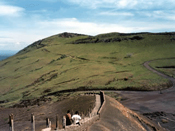MASAYA 2005
Description

Monitoring of CO2 and H2S diffuse emission in the Masaya Caldera. Nicaragua, América Central
Financed by
Instituto Nicaragüense de Estudios Territoriales (INETER) - ITER
Coordinated by
Participants
Abstract
The Masaya caldera is located 20 Km at the southeast of Managua and it is the most unusual active volcano of Nicaragua. This basaltic-andesitic caldera forms a volcanic depression of 11.5 x 6 Km diameter. Since its reactivation in 1993, it has undergone a important degasification process, that is characterized by an stable volcanic plume that give off 3.000 tones of carbone dioxide daily.
The works, that the team INETER-ITER developed in 1999, estimated a daily CO2 diffuse emission level of 28.000 tones in the Masaya caldera (Pérez et al., 2000). A geochemical station was installed to do a continous monitoring of CO2 and H2S diffuse emission in the Masaya Caldera on March 2001 . The aim of this project is to improve and optimize the volcanic surveillance works in Masaya. This geochemical station was able to detect a precursor signal of the 4.2 earthquake that took place the 3rd. of September 2002 near Managua.